It wasn’t supposed to be like that.
I spent Sunday through Wednesday camped out at Cattail Cove State Park on Lake Havasu, about five miles upstream from the Parker Dam on the Colorado River. I put the boat in the water as soon as I arrived and didn’t take it out until I was ready to leave. I was on the boat every day. (I think I’ve used my boat more in the past two months than I have since I bought it in 2011.)
You have to understand one important fact: the winter weather in southern Arizona is perfect. It’s clear every day and the sun warms the air consistently to temperatures in the high 60s to low 80s — unless a cold front happens to blow through and drop daytime temps to the low 60s. It gets chilly at night — I still need to turn the heater on when I get up in the morning — but that’s because all that daytime heating escapes back into space without a blanket of clouds to hold it close to earth. But day after day is beautiful, perfect for just about any outdoor activity.
On Tuesday, I decided to take the boat to Lake Havasu City for lunch. The weather was good, the wind was relatively calm. The city, with its famous relocated London Bridge attracting tourists, was a haven for boaters. There was plenty of docking space and lots of restaurants within walking distance.

This terrible photo is the only one I have of my boat anchored just past the swimming beach at Cattail Cove.
I packed a few things in my small day pack and walked out to the boat, which was anchored just off the beach. I’d set a stern anchor with a fender as a buoy so the boat wouldn’t swing around and get beached if water levels dropped — a trick I’d learned while camping on the Colorado River backwaters in December. The bow line was secured with rocks on shore. That meant I had to wade out to the boat. No big deal; I was wearing a short denim skirt and didn’t get it wet when I carried Penny, my bag, and the bow line out. Within a few minutes, Penny and I were settled in the boat, the stern line was disconnected, and the boat was idling out toward the lake.
I say “idling out” because my boat has no true idle. It’s a sport jet propulsion system — like in a Jet Ski or Waverunner — so it’s always moving. This worked fine at Cattail Cove because there was a big No Wake area all around the beach. As I puttered out toward the lake, I was warming my engine, which, in my opinion, let out a lot of smoke when it was cold. I’ll have it checked and serviced when I get home.
Once past the No Wake buoys, I opened it up to about full throttle. At 5000 RPM, that gives me about 32-35 miles per hour. As the boat accelerates, the front end comes way up out of the water with very little speed gain. Then the front end drops down and it moves, planing over the surface of the water. My little boat loves smooth water — the smoother the better, in fact — and the lake was smooth enough that morning.
I headed upriver, favoring the Arizona side and watching out for hazard buoys that marked underwater “reefs.” When you remember that Lake Havasu is basically a flooded canyon area, those reefs make sense: they’re rock formations that were once rock ridges high above the river surface. As the water levels rose, the ridges became submerged, but some of them are still quite close to the surface of the lake. These hazards are all marked at Lake Havasu — remember, it’s a popular boating destination — so you’d have to be a real idiot to run aground there.
I sped uplake, feeling the warm air blow through my loose sleeveless cotton shirt. I’d tied my hair up with a clip at the back of my head so I wouldn’t be combing knots out of it later in the day. Although the boat has a bimini top, it wasn’t hot enough to deploy it. I was enjoying the feel the sun on my skin. I had a good base tan, especially on my face and arms, after two months mostly outdoors in Arizona and wasn’t worried about burning.
According to my rough measurements on Google Maps, Lake Havasu was about 15 river miles away. That was the longest distance I’d taken the boat that winter. I had plenty of fuel, but knew that my oil situation was less than optimal. My boat’s two-cycle engine has an injector system that takes oil from a reservoir under the hood. I’d poured in the last of the extra oil the previous day but the reservoir was far from full. One of the things I wanted to do at Lake Havasu City was buy more oil.
The trip was uneventful. The landscape around the lake is rugged, rocky desert. There are only a few places where roads can reach the lakeshore and that’s where you’ll find remote desert communities of manufactured homes and RVs. Black Meadow Landing is a community directly across the lake from Cattail Cove. Havasu Palms is another community on the California side about halfway to Lake Havasu City. On the Arizona side, there are numerous boat-in campsites, many of which have ramadas and toilets.
Many of the small coves had fishing boats in them. There was a bass tournament going on — or coming soon; I never did get the whole story — and lots of folks were fishing. There were also numerous pleasure boats speeding one way or another and, closer to the city, quite a few patio boats.
Signs of civilization started up suddenly, right after a construction site. Soon there were buildings and roads and parks on the Arizona side. I reached a No Wake area and cut speed, letting the boat settle back into the water. Then I putted along into the narrow, manmade channel that led to the city’s centerpiece: London Bridge.
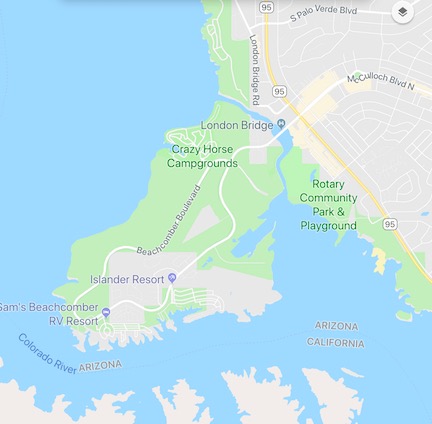
The lay of the land at Lake Havasu City. The canal exists solely so London Bridge has water to cross.
London Bridge — which was the real London Bridge from London, England — was brought out to the Arizona desert as a tourist attraction. Of course, Lake Havasu City didn’t need a bridge. There was nothing for a bridge to cross. So the folks who arranged to buy and move the bridge turned a peninsula of land jutting out into the lake into an island by digging a canal. They then assembled London Bridge in the city to reach the island. You can learn more about it on Wikipedia, which also includes a great photo of the city right after the bridge was assembled.
(The island, by the way, used to have Lake Havasu City Airport on it. They moved the airport about ten miles north of town and redeveloped the land with parks and resorts and condos.)
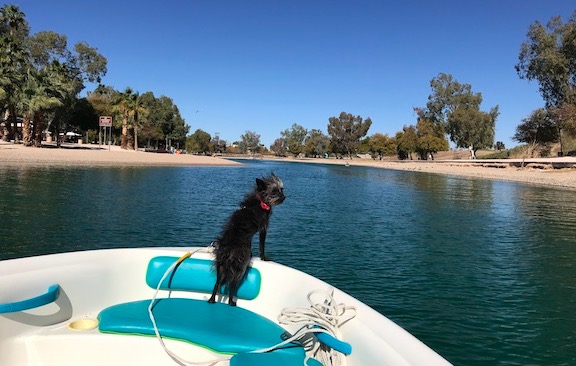
Penny at the bow of the boat as we puttered up the canal toward London Bridge.
My boat is difficult to control at slow speeds, but I managed to set the throttle at a low enough speed to satisfy No Wake rules while maintaining control. This turned out to be about the same speed as a kayaker who was in front of me for most of my drive through the canal. Finally, I saw the bridge and the restaurants and shops clustered around it. There were numerous empty boat slips on the right. Signs said they were public. I aimed the boat into one of them, cut the engine, and drifted in.
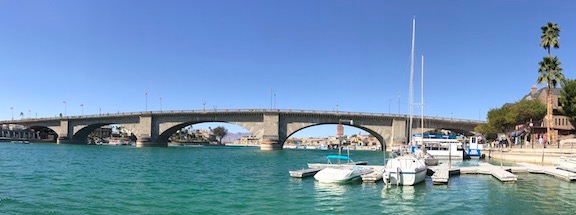
I parked my boat next to a sailboat in one of the empty slips near London Bridge.
Penny was out of the boat before I’d even had a chance to tie up. After securing the fore and aft lines for the boat, I gathered my things and joined her on the floating dock. I fastened her leash and led the way out, through an unlocked gate to a sidewalk where tourists wandered and locals power-walked. I was in search of pizza.
You see, I’d gotten my hands on a Lake Havasu City dining guide and had found a pizza restaurant right near where I parked. I hadn’t had pizza in months. But although it was in the guide, it didn’t seem to exist. I couldn’t find it, anyway. So I kept walking. Soon, I’d walked under the bridge and was running out of options.
There was a fish and chips place with outdoor seating near the bridge and I homed in on it. I fastened Penny to the fence near a table and went in to order. My timing was perfect; a tour boat from Laughlin had just arrived and let off its passengers. Although a loud (possibly drunk?) guy from the boat was in front of me on line, a long line quickly grew behind me. I ordered fish and chips (of course) and a Bloody Mary and went out to wait for my food with Penny.
It was a perfect day for people watching. More than half the folks in the area were seniors who either lived there or were visiting for the day. There was a London style telephone booth near the water that a lot of tourists liked to stand in to pose for photos and I watched them one after another. Other folks milled around while exercise minded folks hurried through. There really isn’t that much to do in the bridge area other than shop in tourist shops.
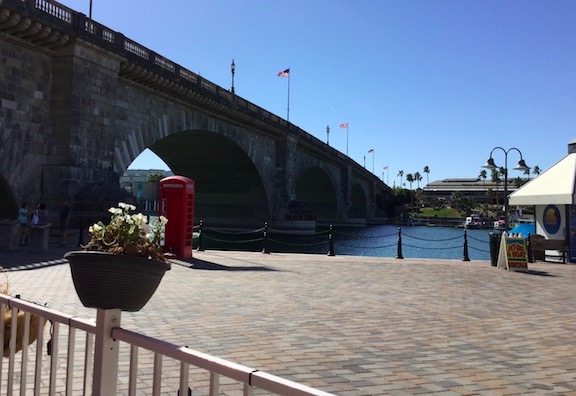
The view from my seat at the fish and chips restaurant on a rare moment with no one on the sidewalk.
My lunch arrived and it was very good. I used malt vinegar on my fries; I really do prefer it over catsup.
As I ate, the wind started to kick up. I got into a conversation with the couple at the next table who were there with a dog. Although I thought at first that they were a married couple, I soon realized that they were either friends or dating. When I offered him the bowl of water the waitress had brought for Penny, he said that his dog preferred iced tea, put the dog on his lap, and let the dog lap tea out of his cup. (Ick.) He then told me that he’d been living in Havasu for a few years and he thought it was paradise. (Coincidentally, that’s what the Welcome to Lake Havasu City signs said.) Then he offered to drive me down to Cattail Cove if I thought it was too windy to make the trip in my little boat. His companion was very agreeable did a lot of nodding.
I thanked them but told them I thought it would be okay.
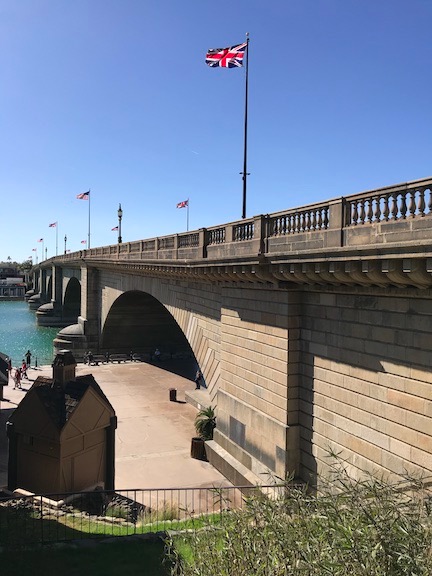
Another shot of London Bridge. The Union Jacks are a nice touch.
A while later, I left in search of ice cream. Instead, I found a Hobie dealer and got to see the full line of Hobie paddle kayaks I’ve been thinking about for the past few years. These boats are very cool. They’re sit-on kayaks with comfortable, removable seats and drop-in pedal propulsion systems. Some models are even compatible with an add-on sail kit and petite outriggers. Before I bought my first kayaks, I considered one of these. But they don’t come cheap and I was worried that I wouldn’t use it. Now I’m thinking that I might, especially if I could figure out a way to take it south with me without towing a trailer or putting it on the roof. In any case, it was good to see them and be able to ask a knowledgeable person questions. The folks there were very helpful, even after I told them I couldn’t buy from them due to inability to transport it. The place is called Southwest Kayaks and they rent kayaks, too; I recommend them if you’re in the Lake Havasu City area. If I’d been staying in the area, I would have rented a kayak with a sail kit just to give it a try.
I went to various places to take photos of the bridge. By that time, the wind was really blowing. We headed back to the boat, stopping only to buy an ice cream cone for me (and a taste for Penny) and take a few more photos. Then we were back on the boat and I was casting off with the engine put-putting in “idle” speed out into the channel. This time, Penny’s life jacket was on and mine was on my seat as a back rest.
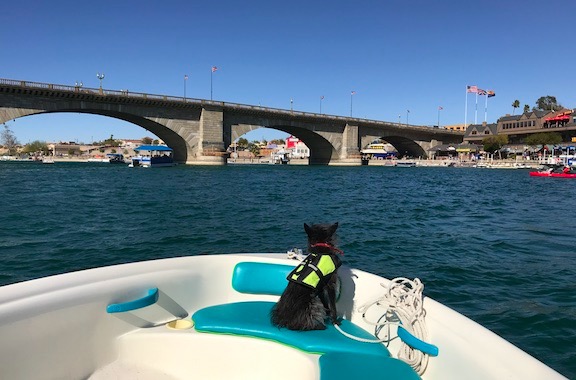
I swung around for one last photo of the bridge before leaving Lake Havasu City.
The water in the channel was smooth enough, but I could sure feel the wind at my back as I retraced my route back out toward the main lake. When I got out of the channel, I could see whitecaps on the water. All the boats I saw were coming in from the lake.
I saw a marina on the right and headed toward it with thoughts of buying fuel and oil. But then I looked at my fuel gauge and realized that at nearly half full I had enough to get back to Cattail Cove. I should have enough oil, too. The wind would only get worse and taking 30 minutes to fuel and get oil I probably didn’t need would just make for a rougher ride all the way back. So I turned back toward the lake and increased speed a little to hurry through the No Wake area. When I passed the last No Wake buoy, I hit the throttle and the boat climbed out of the water into planing cruise.
But it was not a good cruise. The water was beyond just choppy and the boat would periodically surge out of the water while the engine screamed with nothing to pump through it. The hull repeatedly hit the water hard: bam, bam, bam. The fuel gauge swung wildly from nearly empty to half full — what was the real level? And then I heard the first beep.
You see, the oil reservoir has a warning system to let you know when you need to add oil. It beeps when it’s low. When I’m in rough water, the oil level sloshes around and, if it’s low enough, causes that warning system to beep. That basically tells me that I need to add oil pretty soon. If I don’t, the level will get so low that it’ll beep constantly, which is not only annoying, but stresses me out about running out of oil and destroying my engine.
So just like that, my boat told me what it wanted: go back and get more oil. And some fuel probably would be a good idea, too.
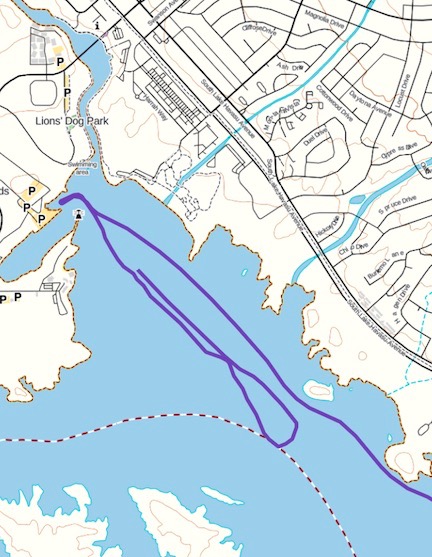
I happened to turn on the tracking feature in the GaiaGPS app on my phone when leaving the No Wake area the first time; you can see the start of the track in the middle of the loop here. You can also see where I turned around, went back to the marina, and then headed back out down the lake.
I turned around and headed into the wind. That was not fun. With the wind at my back, when water splashed up, it splashed away from the boat. But when I was driving into it, the splashes went right into me. I had to slow down to minimize the splashing but somehow that didn’t minimize how wet I was getting.
Then I was past the No Wake buoys and was supposed to slow down a lot more. I slowed down a little more. I honestly didn’t see a reason to maintain No Wake speed. Not only would that have kept me at a virtual standstill driving into the wind, but there was a lot more wave activity from the wind than from my little boat no matter what the speed was.
Eventually, I made it into the marina. It was sheltered there and I had no trouble tying up at the dock. I went right inside to inquire about oil and bought a quart; I usually buy it by the gallon but they didn’t have gallon sized bottles. Then I hit the ladies room. Then I went back to the boat, added the quart of oil, and topped off the fuel. About 20 minutes after arriving, I was ready to get back on the lake.
Of course, just as I expected, things out there were worse. The wind was blowing at around 19 miles per hour. How do I know this? Because at one point I was driving at 19 miles an hour (per my phone’s GPS) away from the wind and my hair and clothes weren’t blowing around. That was seriously weird.
We rode back at the fastest speed I could drive without the boat repeatedly screaming out of the water. That was usually around 15 to 20 miles per hour. At one point, the water seemed calmer and I got it up to 30 miles per hour. But then later I had to slow down again.
The whole time, Penny sat on the seat beside me. I think she wanted to be done with our adventure more than I did.
I drove close to shore, hoping that there would be some shelter from the wind and waves, but it was impossible to avoid them. The wind blasted down the lake, turning the whole surface into a choppy, white capped mess. I thought more than a few times about how nice it would have been to get back to Cattail Cove in a car with that couple from the restaurant and their iced tea sipping dog.
Other than the wind, the weather couldn’t be better. It was still bright and sunny without a cloud in the sky. The air was warm and I saw no need to put on a long-sleeved shirt. The boat wasn’t taking on any water so there was no danger. I did worry a bit — probably needlessly — about the hull banging down on the water surface so many times and mentally rehearsed what I’d have to do if something broke. And there were still a few boats out on the lake so if I had a serious problem and needed help I probably wouldn’t have to wait long.
I finally saw the trailer homes at Black Meadow Landing. Then the buoys at Cattail Cove came into view. I slipped between them and cut speed, maneuvering against the wind to my stern anchor buoy and line. I killed the engine as I reached out and caught the line, then held tight and let the anchor bring us to a stop.
The water in the cove bounced around a little. No one was on the beach. No one was in sight. The wind was howling there, too.
I tied off the line and the boat swung around, leaving the bow over deep water. I could see the bottom, but I knew it was deeper than I wanted to jump into. I repositioned the anchor twice, tossing it toward shallower water each time. Soon, it became obvious that I’d have to get my clothes wet. When I did finally jump in, expecting the water to be up to my thighs, it was up to my waist. And it was cold.
I had half a mind to let Penny swim to shore, but I didn’t. After tying the boat’s bow line to rocks on the beach, I went back to get her and my bag. I walked back to the campsite with my skirt completely soaked and dripping. No one was outside to see me.
It had been a bit more of an adventure than I like, but it was still a great day out.
Discover more from An Eclectic Mind
Subscribe to get the latest posts sent to your email.

While our technology makes it possible for us to occasionally think we’re in charge of things, mother nature has a way of reminding us just how untrue that really is. Your boating adventure is a perfect example; smooth sailing and a quick trip one way, uncomfortable, long, wet, slog back. The only difference, a bit of wind.
Up here in S.E. Alaska, life is connected to the ocean. Whether it’s fishing, transport of basic goods by barge, even whether or not the other high schools basketball team arrives in time for the game depends on the weather and the sea conditions. If you don’t live in the capital (Juneau) you have to budget at least a day or two extra just to get to a jet-capable airport if you want to leave the state. People watch the weather report like their lives depend on it, because sometimes it does. The remoteness and the ruggedness of the terrain adds quite a bit more consequence if you make a mistake boating up here.
If you run out of gas or run aground, it’s unlikely that there will be another boat within sight to help out unless you’re in a popular fishing area in gillnetting season. Even when you do get though to the Coast Guard (they have a pretty good radio relay network) it can be hours or days until help arrives. There are times when no ship or aircraft, no matter how large and capable, can or will brave the conditions when things get really windy and rough. In the winter when it’s blowing hard out in the channel and the temps are low, even the big ferry boats from the Alaska Marine Highway system often cancel their scheduled sailings due to icy spray freezing onto the ship. Not only does it add tons of weight above the waterline (negatively affecting balance and stability), but when they get to their destination they can’t open the door to let the cars and people off because it’s frozen shut. Smaller fishing boats and crabbers can sometimes pound the ice off with sledgehammers, but it’s dangerous work and sometimes it forms faster than it can be removed.
Lake Havasu is known as a powerboat haven, but it can be pretty good for sailing too. The conditions you describe would be perfect for an adventurous sailor on a catamaran or a windsurfer. One thing for sure, boating down south sounds like a LOT more fun in the winter than it is up here!
I don’t think I’d like boating up there, although I admit that I’m very interested in boating the inside passage from Seattle to Alaska — in an appropriate boat, of course.
The good thing about all this is that I was close enough to shore that if I started taking on water I could have pulled in to wait it out. I had a full belly and some snacks and water with me. And my cell phone, which worked on the whole lake.
Hello Sean.
That was great writing.
I have only been to Juneau in the late spring. It was mild and bright then, with good vis, although the ice on Atlin lake (BC) had only just melted.
I can well imagine the winter conditions you describe.
There is something about communities like yours, places in awe of the fickle elements, that hang together with a mutual support which is very deep and empathic.
My wife’s grandad was a (volunteer) lifeboatman in Cornwall. The winter weather there is as violent but not so cold. He was called to a boat in distress, two miles out, force 8 gale.
Their lifeboat was capsized within a minute of setting off. They never thought of not going.
Everyone survived but weather tests character, as you say.
Great adventure, well told.
Here we just mix the oil with the gas at the correct ratio (50:1, 25:1) depending on the engine. Stihl chainsaw 50:1, brush cutter 30:1. That way the oil mix is always right and not too smokey.
Ah, THAT London Bridge! Forgive me if I wander back…
As a kid my uncle Jack walked me across that same span when it crossed the Thames in England. My dad was the youngest of five kids, his brother Jack the eldest. Jack had fought in the First World War in the (horse-drawn) artillery. He was at the awful battle of Ypres in 1917, in foul weather, when his field gun and 8-horse team was pulled into sloppy deep mud. Six of his much loved horses drowned in that filth. He cut two free and saved himself.
After that he was lost and angry, utterly fearless and beyond discipline. In his seventies, still running a shop in London, a robber with a sawn-off 12 gauge stuck the gun in Jack’s ribs and said : “Empty the till in this bag”
Jack just laughed at him.
The robber left.
Your Uncle Jack sounds like a cool dude.
My chainsaw, weed whacker, and leaf blower all use premixed fuel. This boat does not. The injector is supposed to measure out the right amount of oil. I’ll have it checked when I get home.
I think my uncle Jack (long dead) would have got along fine with your eccentric uncle in NJ. The guy who fires his guns in the house.